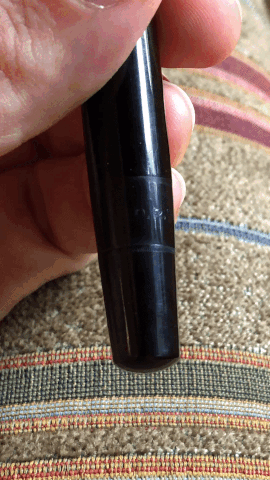top of page
No. 235

The 23x series was positioned in between the more expensive 12x or 13x Meisterstück series and the cheaper economy 33x series. Catalogues explained that "the proven quality of this price range (2xx) created the worldwide reputation of the Montblanc brand". The "2" digit in this model signifies the pen was from the second-tier series. The "3" in the model number signifies that it was a piston filler, and the last "5" signifies its nib size.
The No. 235 is a rather special pen to me. It is special from a historical point of view because it was part of introducing the Kontrolfüller technology to Montblanc which was successfully used in future series and models. The "Patent Angem", short for patent angemeldet (patent pending), imprint on the piston section at the bottom of the barrel testifies to this fact, because it was soon replaced by D.R.P. 652405 on the 234 1/2 (the eventual successor of the 235). This patent relates to the design of an ink window, which was advertised as allowing one to now see the level of ink in the pen. The 235 is also special because it is very very rare! Collectible Stars I rates it a 4 out of 12, but I think that's a typo! Tom W. called it as rare as hens' teeth, and Osman S. told me to stop dreaming of unicorn pens (two weeks before he found this one for me, lol!).
There is a bit of mystery surrounding the manufacture and quick discontinuation of the 235. I could not find any German catalogue that mentions the model "235". But, the book Montblanc in Denmark by Claus Holten and Poul Lund shows a page from a 1936 Danish catalogue that is identical to the 1936 German catalogue, except that it clearly calls the pen a "235". In the German version of the catalogue, the pen is referred to as the "234". Further, the German catalogue explains that the 234 was earlier called "17 1/2", formally replacing the two-digit numbering system with the three-digit system. The catalogue explains the same for other models too, renaming the 17 1/2 safety filler to the No. 204 safety, and the 17 1/2 push-knob filler to the 224 push-knob. Collectible Stars I dates the piston 17 1/2 to c. 1934 (for one year), the 235 to c. 1935 (for one year), and the 234 to c. 1936 (for one year). In conclusion, it seems that MB first changed the name from "17 1/2" to "235" and then very quicky to "234". But, we're talking about the same pen essentially. Why did MB do this? I don't quite know. Maybe they realized the "5" was not a standard pen size, and customers were used to even-digit model numbers? Also, interestingly, the 234 itself is found nowhere in subsequent catalogues and seems to have been replaced by the 234 1/2 which enjoyed a rather successful run.
Instruction manual, notice the No. 5 nib
Pic Credit: Poul Lund
The 235 is also considered to be the first piston filler that MB made. Technically speaking though, the architect drawing pen was the first piston filler MB made in early 1920, even before Pelikan came out with its historical piston filler in the late 1920s. But, in terms of mainstream production, the 17.5/235/234 were the pens that introduced the simple piston filler to MBs line up. This technology was then used in MB's tier-2 and tier-3 pens for the next two decades. But, it seems MB did not find this worthy of patenting. I guess it was very close to what Pelikan had already made. The telescopic piston, though, was patented by MB in 1937 (patent link), but that was for it's 13x series and some 23x models for a short time post-1937.
While it may not have been super innovative, MB did advertise the piston of the 235 (shown as the 234 in the catalogue picture here) as being technologically superior because of its brass spindle instead of cheap plastic like other manufacturers.





In terms of size, the 235 is not a large pen. It measures 13.5 cm capped, and according to Collectible Stars I this is the same size at the 17 1/2 and 1mm longer than the 234 and 234 1/2. With regard to material, the 235 is celluloid on the barrel and what seems ebonite on all other parts. This makes sense because a transition was being made from hard rubber to celluloid at the time and so many MB models from the period are mixes of ebonite and celluloid. According to Collectible Stars I, the 235 came in colours like black, burgundy red, malachite green, and azurite blue. The 1936 catalogue for the 234 suggests that the pen was available in these colours, and so we can assume it was the same for the 235. Finally, the 235 was not a cheap pen - the Danish cataogue pictured in this article proposed a price only slightly higher than that of the platinum "PL" series.
For bibliography, see Resources page -->link

1936 German catalogue introducing the 234.


1936 Danish catalogue introducing the 235.
Pic Credit: Montblanc in Denmark 1914-1992

bottom of page